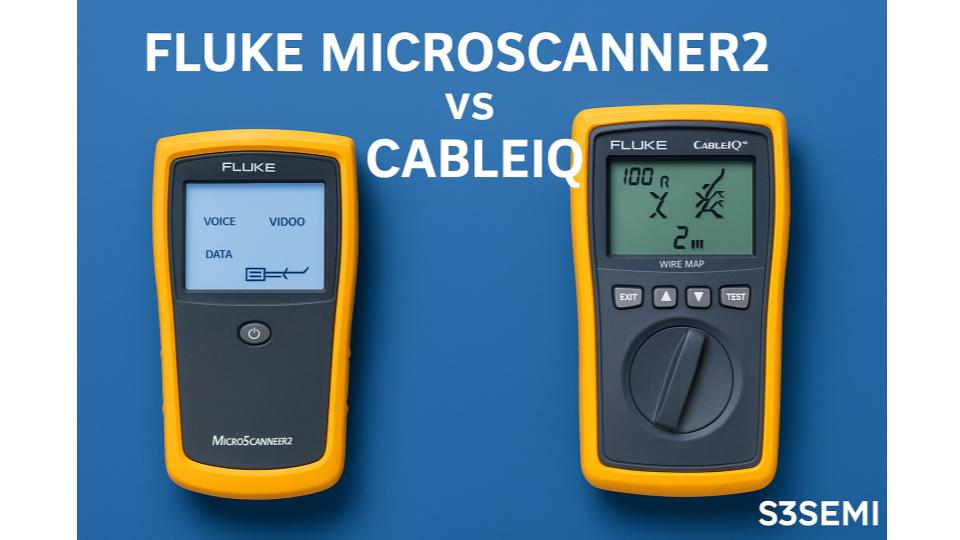When working with copper and network cabling, choosing the right tester can make a huge difference in both troubleshooting efficiency and installation verification. Fluke offers two popular handheld testers — the MicroScanner2 Cable Verifier and the CableIQ Qualification Tester. While they look similar, they serve different purposes. Let’s explore the key differences.
📋 Overview of the Fluke MicroScanner2
The Fluke MicroScanner2 is a cable verifier designed for quick and simple testing of copper, coax, and telecom wiring.
Key Features:
- Tests copper, coax, and telephone cables
- Detects wiring faults: opens, shorts, miswires, split pairs
- Provides wiremap results on an intuitive LCD display
- Length measurement via TDR (Time Domain Reflectometer)
- Identifies cable IDs and toner for cable tracing
- PoE detection support
- Rugged handheld design
The MicroScanner2 is best for installers and technicians who need to verify wiring integrity during installations and service calls.
📋 Overview of the Fluke CableIQ
The Fluke CableIQ is a qualification tester, designed to determine whether existing cabling can support higher network speeds.
Key Features:
- Qualifies cabling for 10/100/1000 Ethernet and VoIP
- Measures bandwidth capacity of copper cabling
- Detects wiring faults (opens, shorts, miswires, split pairs)
- Provides detailed length and distance-to-fault measurement
- Intelligent diagnostics for troubleshooting network performance issues
- Identifies cable types and connected devices (switch/hub/router)
- Rugged handheld tester with intuitive interface
The CableIQ is aimed at network professionals who need to validate or troubleshoot cabling for performance, not just continuity.
⚖️ Side-by-Side Comparison
| Feature | Fluke MicroScanner2 | Fluke CableIQ |
|---|---|---|
| Cable Types Supported | Copper, coax, telephone | Copper (Ethernet) |
| Wiremap | ✅ Yes | ✅ Yes |
| Fault Detection (opens, shorts, miswires, split pairs) | ✅ Yes | ✅ Yes |
| Length Measurement | ✅ Yes (TDR) | ✅ Yes (TDR) |
| PoE Detection | ✅ Yes | ✅ Yes |
| Bandwidth Qualification | ❌ No | ✅ Yes (up to 1 Gbps) |
| Network Device Discovery | ❌ No | ✅ Yes |
| Best Use Case | Cable verification | Network qualification & troubleshooting |
| Price Range (approx.) | $$ | $$$ (higher) |
👍 Pros and Cons
Fluke MicroScanner2
✅ Affordable and easy to use
✅ Supports multiple cable types (copper, coax, telecom)
✅ Excellent for verifying wiring integrity
❌ Cannot test bandwidth or network performance
❌ More limited in diagnostics
Fluke CableIQ
✅ Qualifies cable performance for up to Gigabit Ethernet
✅ Detects and diagnoses network issues
✅ Ideal for validating existing cabling infrastructure
❌ More expensive
❌ Focused mainly on Ethernet — less versatile for coax/telecom
🛠️ Which One Should You Choose?
- Choose the Fluke MicroScanner2 if you are a cabling installer or technician who mainly needs to verify wiring integrity quickly and across multiple cable types.
- Choose the Fluke CableIQ if you are a network professional or IT technician who needs to ensure existing cabling can support specific network speeds and troubleshoot performance issues.
💡 Final Thoughts
Both testers are excellent tools, but they serve different roles.
The MicroScanner2 is a cable verifier, focused on making sure the wiring is correct, while the CableIQ is a qualification tester, focused on network performance.
If you work mostly with installations, the MicroScanner2 is the practical choice. If your job involves ensuring cabling can support modern Ethernet speeds, the CableIQ is the more powerful tool.
